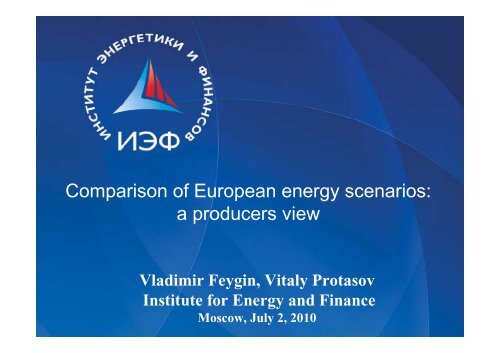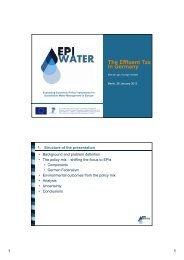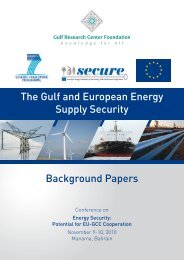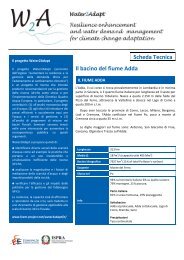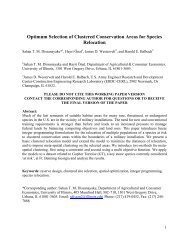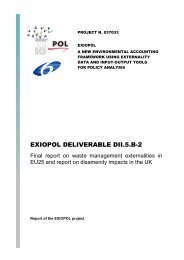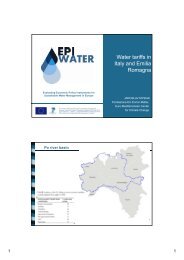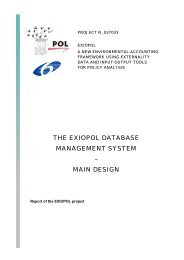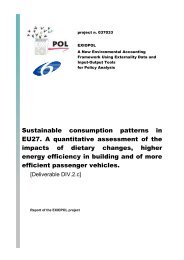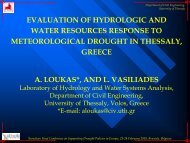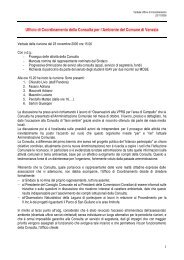Comparison of European energy scenarios: a ... - Feem-project.net
Comparison of European energy scenarios: a ... - Feem-project.net
Comparison of European energy scenarios: a ... - Feem-project.net
Create successful ePaper yourself
Turn your PDF publications into a flip-book with our unique Google optimized e-Paper software.
<strong>Comparison</strong> <strong>of</strong> <strong>European</strong> <strong>energy</strong> <strong>scenarios</strong>:<br />
a producers view<br />
Vladimir Feygin, Vitaly Protasov<br />
Institute for Energy and Finance<br />
Moscow, July 2, 2010
2<br />
The research on models and <strong>scenarios</strong><br />
<strong>of</strong> <strong>energy</strong> development<br />
An Analysis <strong>of</strong> available Energy Sector Forecasts<br />
and Scenarios (FaS): assumptions, methodology,<br />
results, uncertainties<br />
In the <strong>net</strong>work <strong>of</strong> EU-Russia Energy Dialog<br />
(Thematic Group on Strategies, Forecasts and<br />
Scenarios)<br />
In support from the Ministry <strong>of</strong> Energy <strong>of</strong> Russia and<br />
from Gazprombank Ltd.<br />
More then 40 different <strong>scenarios</strong> are already<br />
investigated
3<br />
Differences in methodological approach <strong>of</strong> EU and<br />
Russian teams<br />
EU approach: model, based on economic, political,<br />
pricing, etc assumptions. Modeling <strong>of</strong> behavior <strong>of</strong><br />
economic agents. Integrated analysis<br />
Russia approach: interaction <strong>of</strong> ministries,<br />
companies, research institutes and experts.<br />
Creating “rational” ways <strong>of</strong> <strong>energy</strong> development.<br />
Models play supportive role<br />
We need to bring together Russia and EU<br />
approaches to improve quality <strong>of</strong> FaS, use results <strong>of</strong><br />
each other’s analysis in mutual needs
4<br />
Methodology: the main parts <strong>of</strong><br />
analysis<br />
Model content
5<br />
<strong>Comparison</strong>: model content
6<br />
<strong>Comparison</strong>: assumptions
7<br />
<strong>Comparison</strong>: Mechanism <strong>of</strong> modeling
8<br />
<strong>Comparison</strong>: Production chain and <strong>energy</strong><br />
markets (1)
9<br />
<strong>Comparison</strong>: Production chain and <strong>energy</strong><br />
markets (2)
10<br />
<strong>Comparison</strong>: results
11<br />
Modeling is viewed as a set <strong>of</strong> black (grey?)<br />
boxes<br />
New modeling approaches?
12<br />
Assumptions: EU GDP growth<br />
PRIMES EU GDP assumptions are a little bit<br />
higher than in WEO
13<br />
EU population growth<br />
Demographic assumptions are almost equal<br />
Persistence <strong>of</strong> demographic process simplify<br />
an analysis
14<br />
<strong>Comparison</strong> <strong>of</strong> assumptions: prices<br />
Gas price in EU in 2020 in PRIMES is 16% higher than<br />
in WEM-2009 (with almost equal oil prices)<br />
PET (TIMES) uses forecast from WEO-2008
15<br />
Assumptions: prices<br />
In 2005-2020 in PRIMES oil prices rise at 12-<br />
84%, while gas prices at 33-124%<br />
Gas price oil link? Reasons for higher gas price<br />
growth?<br />
Source: Second Strategic Energy Review, 2008
16<br />
ETS price
17<br />
Gas balance in EU, 2020, mtoe<br />
HOG = High oil and gas prices; for ENTSOG ‐ 2019<br />
PRIMES ENTSOG*<br />
Scenarios BL-2007 BL-2007-HOG NEP NEP-HOG BL-2009 No policy-<br />
2009<br />
Consumption 505 443 399 345<br />
462 513<br />
555,7<br />
Net import 390 330 291 245 351 401 438,4<br />
Import<br />
dependence, %<br />
2009<br />
77,2 74,5 72,9 71 75,9 78,2 78,9<br />
RES-2020 (PET, TIMES) Eurogas IEA<br />
Scenarios BL BL-RES BL-RES-20 BL, HOG Brussels,<br />
2009<br />
Ref 450<br />
Consumption 429 414,9 464 539,1 578 463 429<br />
Net import 332,2 318,1 324,6 425,4 480 349 321<br />
Import<br />
dependence, %<br />
77,4 76,7 70 78,9 83,0 75,4 74,8
18<br />
Importance <strong>of</strong> average growth rates analysis<br />
Problem <strong>of</strong> different base year data<br />
Problem <strong>of</strong> different units (incl. calorific values<br />
<strong>of</strong> gas)
19<br />
Gas producers forecasts<br />
Gas producers are more optimistic<br />
Note: Eurogas and Eni for EU-27, ExxonMobil, Gazprom, Statoil for OECD-Europe, Edison for EU-27+Turkey+Norway+<br />
Switzerland, IGU for EU-27+Turkey+Norway+Switzerland+Balkans; Eni, Statoil, IGU from 2010, others from 2009<br />
Sources: company data
20<br />
<strong>Comparison</strong> <strong>of</strong> scenario groups by<br />
Groups <strong>of</strong> <strong>scenarios</strong>:<br />
authors<br />
Governmental (usually are provided by research institutes)<br />
Independent research <strong>of</strong> institutes and international<br />
organizations<br />
Producers <strong>scenarios</strong><br />
Consulting companies <strong>scenarios</strong><br />
Note: Government: EIA, PRIMES, ENTSOG (9 <strong>scenarios</strong>); Researchers: IEA, RES-2020 (PET, TIMES) (6 <strong>scenarios</strong>); Producers: Eurogas,<br />
ExxonMobil, Gazporm, Edison, Eni, Statoil, IGU (9 <strong>scenarios</strong>); Consulting companies: CERA, Wood Mackenzie, LEA, IEC (6 <strong>scenarios</strong>)
21<br />
Conclusions and open questions<br />
Uncertainties – objective and subjective<br />
Forecasts <strong>of</strong> models differ a lot from each other<br />
It seems to be only one way to make efficient progress -<br />
cooperation <strong>of</strong> EU, Russia and World experts at<br />
permanent base with proper governmental support<br />
Importance <strong>of</strong> growth rates analysis<br />
Optimism <strong>of</strong> producers and consulting agencies<br />
In 2020-2030 gas consumption increase looks to be<br />
lower than in 2009-2020
Conclusions and open questions (2)<br />
Some questions yet without comprehensive answers:<br />
- IEA-2009 pessimistic view on role <strong>of</strong> gas (both for the EU and US:<br />
coal renaissance while gas is stagnant);<br />
- EU-2009 press on biomass and EU-2010 press on wind:<br />
- detailed understanding <strong>of</strong> an economic impact <strong>of</strong> various<br />
<strong>scenarios</strong> on consumer prices; role and scale <strong>of</strong> subsidies; degree<br />
<strong>of</strong> certainty on technological shifts etc.<br />
EU-2008 Alternative <strong>scenarios</strong> look now far from being the only way<br />
to reach “20-20-20” targets<br />
Current dramatic shift in views on the US gas perspectives<br />
Development <strong>of</strong> an information panel on available <strong>scenarios</strong> and<br />
forecasts<br />
Necessity to intensify efforts in expert evaluation <strong>of</strong> <strong>scenarios</strong> and<br />
on harmonization <strong>of</strong> forecasts
Thank you for your attention!


